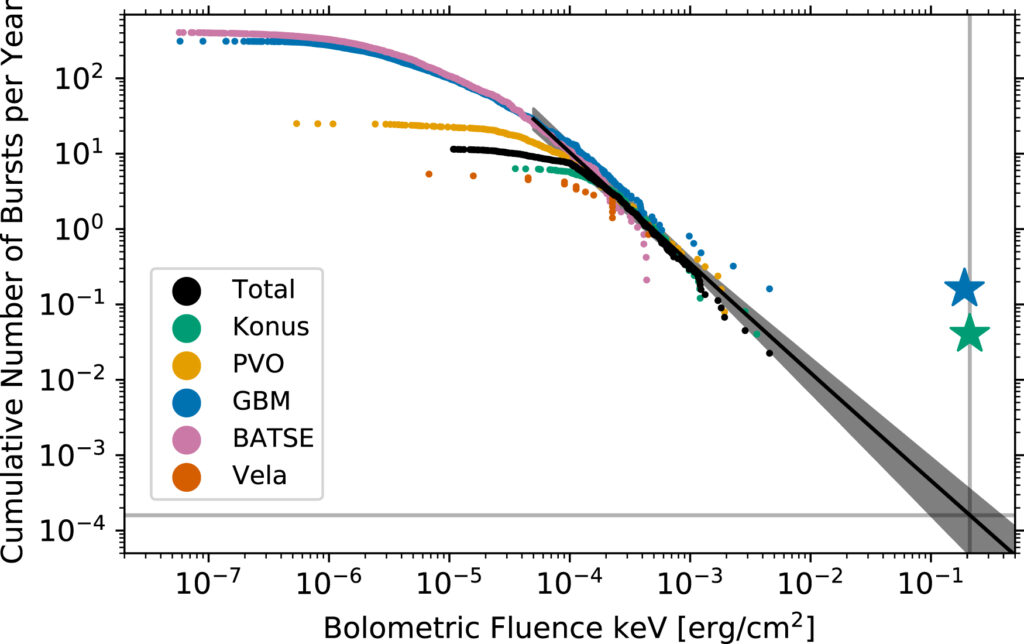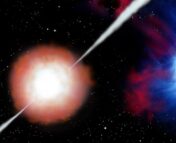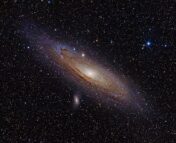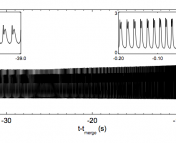Paper Title: Fermi-GBM Discovery of GRB 221009A: An Extraordinarily Bright GRB from Onset to Afterglow
Authors: S. Lesage, P. Veres, M.S. Briggs, A. Goldstein, D. Kocevski, et al.
First Author’s Institution: Department of Physics and Astronomy, Louisiana State University, Baton Rouge, LA 70803 USA
Status: on arXiv, open access
And
Paper Title: GRB 221009A: The BOAT
Authors: Eric Burns, Dmitry Svinkin, Edward Fenimore, D. Alexander Kann, José Feliciano Agüí Fernández, et al.
First Author’s Institution: Department of Physics and Astronomy, Louisiana State University, Baton Rouge, LA 70803 USA
Status: Published in ApJL, open access (part of a special issue for this burst)
On October 9th, 2022, the astronomy community was energized by an extremely bright long gamma-ray burst – GRB 221009A, which has been referred to as the Brightest of All Time (BOAT). This exciting and rare burst was followed up by observatories and telescopes around the world and in space in real-time, with more than 100 notifications sent to the community from many collaborations and observatories.
Long gamma-ray bursts (GRBs) are typically associated with the deaths of massive stars. They are extremely energetic extragalactic objects (outside of our own Milky Way galaxy), and can emit across the electromagnetic spectrum, although their name comes from the gamma-ray photons (the highest energy photons on the spectrum) that we observe from them.
GRB 221009A was initially detected by the Gamma-ray Burst Monitor (GBM) onboard the Fermi satellite at 13:16:59.99 UTC. An hour later, the Swift satellite came into view of the source and detected this burst (for more information about the Swift detection, check out this Astrobite). This burst broke records for its brightness, and was also the first detection of a photon above 10 TeV from a gamma-ray burst (reported by the LHAASO collaboration). It was even seen by the Voyager 1 satellite (on October 8th rather than October 9th, since Voyager is now more than 14.7 billion miles from Earth).
The burst broke records for its brightness, and was also in an interesting location – it was fairly nearby (redshift of 0.151), and in the plane of our galaxy. It lasted only a few hundred seconds (about 4.8 minutes in the brightest part of the burst), but this is also extreme for a GRB; this burst was longer than 96.4% of all long GRBs detected by Fermi-GBM.
These two papers describe the view of GRB 221009A as seen by Fermi-GBM, and compare this GRB to previous GRBs detected by GBM, to get a view of how exceptional and exciting this burst is.
Photon traffic jam
This GRB was so bright that it saturated both GBM and the Large Area Telescope (LAT) on the Fermi satellite. Saturation is an effect where the rate of photons in the detector is so high that the instrument can’t keep up. This is a known effect which can normally be compensated for; however, because this burst was so bright, the count rate exceeded 50,000 photons per second(!) which causes more complex effects in the detectors, such as pulse pile up.
Once the correction was applied, the true brightness of this burst was revealed (Figure 1). At the brightest part of the burst, GBM saw nearly 6 million photons per second.

Comparison to other GRBs
So far, we’ve seen that this was a very bright burst – but how does it compare to other GRBs we’ve observed in the past?
Today’s second paper (by Burns et al.) sets out to compare this GRB to historical GRBs seen in gamma rays. They use 5 different satellites, all operating in the keV-MeV gamma-ray energies: the Vela satellites, Pioneer Venus Orbiter (PVO), Burst And Transient Source Experiment (BATSE), Konus-Wind, and Fermi-GBM.
The authors look at the fluence (flux integrated over both time and energy) of these bursts, to see how much energy was observed in the different instruments over the full duration of the burst, and compare that to historic GRBs in the sample. We see that this burst is well above the fluence observed from previous bursts, and is exceptionally bright at Earth (see Figure 2).
It’s also interesting to note that the second brightest burst observed came only a few months later, in March of 2023 – GRB 230307A. Its redshift isn’t known, but the authors do include it in the comparisons of fluence of all the bursts in Fig 2. Still, GRB 221009A is almost 50 times brighter than this second brightest burst.

Clearly, this was a very bright burst at Earth – but what about at its source? For this, the authors look at two quantities, the Eiso (the total energy emitted at the source) and the peak luminosity, Liso, (the power radiated at the peak of its emission).
Figure 3 shows the comparison of GRB 221009A to many other GRBs’ Eiso values. We see that this burst sets a new record for Eiso as well, making it the GRB with the highest energy output at its source as well as highest fluence at Earth.
For Liso, the peak luminosity, two other GRBs are slightly higher – GRB 110918A and GRB 210619B. However, GRB 221009A still clocks in the 99th percentile for the peak luminosity, and is still one of the brightest ever observed.

A look ahead
GRB 221009A is truly exceptional – the brightest gamma-ray burst ever seen. This burst is exceptionally rare, possibly even as rare as one-in-10,000 years! It’s given astronomers insight into these powerful transients, as well as into our own galaxy through dust rings seen by several instruments. Its brightness, as well as its proximity give us an exciting window into our universe.
Astrobite Edited by: Lindsay DeMarchi
Featured image credit: ESO/A. Roquette, CC BY 3.0, via Wikimedia Commons





Hi Jessie
A study 2306.06372 on 221009A, suggests that the biggest # of hits an energy segment with Emedian = 1.62 TeV
Do you know by chance if these photon energies are corrected for cosmological redshift, and if that is a common approach in articles concerning GRBs? If they are corrected for, that energy peak lands upon 13-fold Higgs mass which was predicted in May 2021 for the next massive particle to be found according to LPM.
Thank You!
Hi, thanks for your question. I have read the paper you suggest, but am not an expert on it. I am not sure which plot you’re referring to that shows the largest number of hits in this energy bin? In general, I believe correcting energies for cosmological redshift is a common approach that is done in most papers. Since I am not an expert on this paper, I suggest that you reach out to the authors of the arXiv:2306.06372 paper for more information.